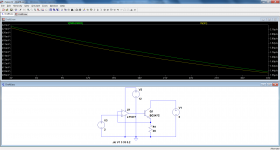An interesting take on a common source of flicker noise...
http://rubiola.org/pdf-articles/conference/2004-fcs-dc-amplifier.pdf section III, "page 472"
Hmmmm, could be why there are such different numbers for BF862 noise measurements.
yes! This is what I found and very well could explain the difference in noise.
Thx,
Richard Marsh
Thanks for the help Richard, although I ended up finding my own solution.
Alway's enjoy it when we take a turn or make discovery... especially for ourselves. Or, just find a different view of the same thing. It's all good.
-Richard
Last edited:
Any way you could also test a jfet-jfet cascode (Maybe a 2SK369 under a J111?) and show comparative results?
mlloyd1
I found some J111. See what I can do. What about the 2SK372-v and J111? They have leads and I dont need a microscope to see it?
THx-RNMarsh
Thank you. lms.
Also, Early Effect: www.Ohio.edu/people/starzykj/network/class/ee715/labs/elements/lab4.pdf
THx-RNmarsh
Also, Early Effect: www.Ohio.edu/people/starzykj/network/class/ee715/labs/elements/lab4.pdf
THx-RNmarsh
Yes. And low noise as well. Of Sanyo extraction.
its hilarious, the datasheet says the fet is equivalent to a 60 V 75 A power mosfet...
In fact, the Vbe variation is a secondary consequential effect of the prime cause, which is the Hfe variation.Previously, glaring at the Early effect equation did not leave me any the wiser about the relationship between Vce and Vbe. Things are making more sense now however, so I pulled the Early effect equation inside out in order to plot theoretical Vbe vs Vce at constant Ic. I used parameters from my BC337-40 model.
X axis is Vce. This chart shows that at 1Vce, Vbe changes by about 246uV per volt Vce. This corresponds to a PSRR of about 72db which lines up with my experience.
This can be demonstrated in this simple "thought experiment": in this circuit, the collector current is kept constant to ~10e-3.
The transistor belongs the C group, meaning highest Hfe for minimal current error, and also highest Early effect.
For a 1 to 31V Vce variation, the base current changes from 2.2µA to 1.4µA, while at the same time Vbe changes from 621.5 to 610mV.
26*ln(2.2/1.4)=621.5-610, thus everything falls nicely in place
Attachments
Last edited:
its hilarious, the datasheet says the fet is equivalent to a 60 V 75 A power mosfet...
Why not? Using IRFP240's as MC amplifier gives also real good results (only tied in sim until now). One large (MOS)FET can be seen as many... many devices in parallel. SO the question is: Why not?
Why NOT just buy a Flir for your iPhone, Then you have really good thermal shots
Quite expensive for now (€ 285,00) but it’s just the beginning
FLIR thermography camera, , 80 x 60 pix bolometer matrix from Conrad.com
"With a slim case which attaches to an iPhone 5 or 5s, FLIR ONE turns a smartphone into a thermal infrared camera, giving the ability to “see” and measure minute temperature variations on the phone’s screen. Fitted with two cameras, including a long-wave infrared Lepton sensor, the FLIR ONE uses MSX Technology to provide thermal imaging capability and sharpness by blending the thermal and visible spectrum. This technology allows the FLIR ONE to detect temperature differences as small as 0.1 °C across a range of 0°C to 100°C."
Why not? Using IRFP240's as MC amplifier gives also real good results (only tied in sim until now). One large (MOS)FET can be seen as many... many devices in parallel. SO the question is: Why not?
After all, power transistors at the input of low level, low noise preamplifiers have been suggested again in the past due to their claimed low base resistance
Example: Extreme Low Noise Preampifier
George
A question for Scott.
Is SSM2220 actually the same die as MAT03, just different package ?
Thanks,
Patrick
I don't think so, but I'm not 100% sure. Derek is gone, so I'm not sure who to ask either.
Why not? Using IRFP240's as MC amplifier gives also real good results (only tied in sim until now). One large (MOS)FET can be seen as many... many devices in parallel. SO the question is: Why not?
Yes power bipolars if selected, they never specify noise in any way, have been known to do .3nV and they don't heat up. They have big Cj's but far less than JFET's .
EDIT- missed the link is already posted above.
Now I'm up against device low Vp. What to do next.... need minimum 3v ?
THx-RNMarsh
Hi Richard
In the old days we used an lm394 diff amp for a thermocouple amp. Inside it was a large number of parallel transistors which gave it the low noise and "matched" properties. I looked this morning and see it is discontinued, my trusty row of old "Blue national books" obsolete.
If i could ask (not recall seeing it) what is the magnitude, bandwidth and source impedance of your input signal?
Best,
Tom
This is what drove the earlier question about temperature and noise.
Understanding CCD Read Noise
A question for Scott.
Is SSM2220 actually the same die as MAT03, just different package ?
Thanks,
Patrick
The SSM circuits were independently designed and the MAT0x series already subsumed into Analog Devices before SSM was also taken over, so I suspect they are different die.
An interesting puzzle to fit a 75 amp power mosfet into a sot23 package...Why not? Using IRFP240's as MC amplifier gives also real good results (only tied in sim until now). One large (MOS)FET can be seen as many... many devices in parallel. SO the question is: Why not?
An interesting puzzle to fit a 75 amp power mosfet into a sot23 package...
Don't worry, it's a typo in the datasheet. Power mosfet are almost always of the enhancement type (no Idss), and the die size would cover more than 4xSOT23.
- Status
- Not open for further replies.
- Home
- Member Areas
- The Lounge
- John Curl's Blowtorch preamplifier part II
